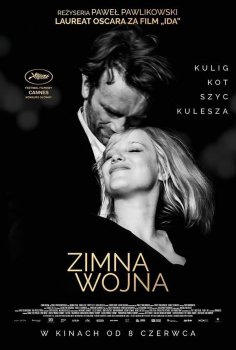Review Detail
Pawel Pawlikowski’s ‘Cold War’ Mirrors Gloomy Mood of 1960s Poland
By VALENTINA I. VALENTINI on Variety.com
The first project on which director Pawel Pawlikowski and cinematographer Lukasz Zal ever collaborated won an Oscar. In 2015, “Ida,” shot in black and white, took home the foreign language Oscar, with Zal nominated for cinematography (shared with Ryszard Lanczewski).
Now, their second project, “Cold War,” also in black and white, is on the film festival circuit and already copping some prestigious prizes — for example, the director trophy at Cannes for Pawlikowski.
The film, a tragic love story spanning Europe and the political and cultural upheaval of the 1950s and ’60s, will be released in the U.S. on Dec. 21.
The duo did not initially intend to shoot black and white on their second collaboration, but they simply couldn’t find the right palette to visually invoke the film’s time period and locations.
“When we originally considered shooting in color,” says Zal, “it struck us that we would have been stuck with a look resembling [East German 1960s] film stock. Unlike America [of that time], wonderfully portrayed in Todd Haynes’ ‘Carol’ with its vibrant colors, Poland in that period was drowning in different shades of gray; there was no color.”
RELATED
With War in the Rear View Mirror, Croatia Has Made Filming a Major Business
'The Glass Room's' Historic Czech Building Provided Context, Atmosphere
Pawlikowski and Zal also reconsidered their decision to shoot on film, but before switching to digital, they did a comparison shoot with a 35mm camera and the Arri Alexa SXT digital camera in tests using the same lenses — Angénieux Ultra Primes — on the same set and with the same lighting. Production designers Marcel Slawinski and Katarzyna Sobanska-Strzalkowska, both of whom worked on “Ida,” built a set based on the lead characters Zula and Wiktor’s apartment, where they shot rehearsals with the actors, Joanna Kulig and Tomasz Kot, in different costumes and makeup, with different shades of black, white and gray.
After developing and scanning the Kodak 5219 film stock with colorist Michal Herman, they performed the grading on 35mm and found the look they were going for.
“Then we decided to find an equivalent on the Alexa and master it to the point that it would be hard to distinguish it [from film],” says Zal. So, along with his team, he perfected a method to re-create the look of the 35mm images, both in terms of contrast and body.
Once on set, they were able to put their plans into practice. “[We got] dailies and a final cut that were very close to the image we had wanted from the start,” Zal explains. “By reopening the blacks … or by playing on micro-contrast, the final round of color timing resulted in an image that I find very rich, that looks just like film, but that has stronger details in the blacks especially.”



